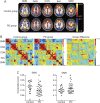CSF proteins and resting-state functional connectivity in Parkinson disease
- PMID: 25979701
- PMCID: PMC4478033
- DOI: 10.1212/WNL.0000000000001681
CSF proteins and resting-state functional connectivity in Parkinson disease
Abstract
Objective: The purpose of this study was to investigate the relationship between disruption of MRI-measured resting-state functional connectivity (rs-fcMRI) brain networks and CSF levels of potentially pathogenic proteins that reflect brain pathology in Parkinson disease (PD).
Methods: PD participants without dementia (n = 43) and age-matched controls (n = 22) had lumbar punctures to measure CSF protein levels, Pittsburgh compound B (PiB)-PET imaging, and rs-fcMRI while off medication. Imaging analyses focused on 5 major resting-state networks as well as the striatum.
Results: Participants with PD had significantly reduced sensorimotor functional connectivity, which correlated with reduced CSF levels of α-synuclein. The PD group also had significantly stronger default mode network functional connectivity that did not correlate with CSF β-amyloid (Aβ)42 or PiB uptake. In contrast, default mode network functional connectivity in the control group did correlate with CSF Aβ42 levels. Functional connectivity was similar between groups in the dorsal attention, control, and salience networks.
Conclusion: These results suggest that abnormal α-synuclein accumulation, but not Aβ, contributes to the disruption of motor-related functional connectivity in PD. Furthermore, correlating CSF protein measures with the strength of resting-state networks provides a direct link between abnormal α-synuclein metabolism and disrupted brain function in PD.
© 2015 American Academy of Neurology.
Figures




Comment in
-
Biomarkers in Parkinson disease: It's time to combine.Neurology. 2015 Jun 16;84(24):2392-3. doi: 10.1212/WNL.0000000000001692. Epub 2015 May 15. Neurology. 2015. PMID: 25979702 No abstract available.
References
-
- Wu T, Wang L, Chen Y, Zhao C, Li K, Chan P. Changes of functional connectivity of the motor network in the resting state in Parkinson's disease. Neurosci Lett 2009;460:6–10. - PubMed
-
- Helmich RC, Derikx LC, Bakker M, Scheeringa R, Bloem BR, Toni I. Spatial remapping of cortico-striatal connectivity in Parkinson's disease. Cereb Cortex 2010;20:1175–1186. - PubMed
-
- Esposito F, Tessitore A, Giordano A, et al. Rhythm-specific modulation of the sensorimotor network in drug-naive patients with Parkinson's disease by levodopa. Brain 2013;136:710–725. - PubMed
Publication types
MeSH terms
Substances
Grants and funding
LinkOut - more resources
Full Text Sources
Medical
Miscellaneous
